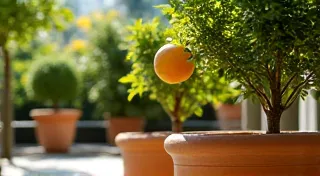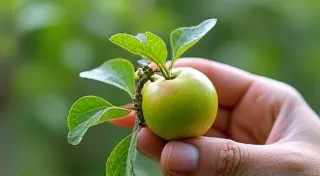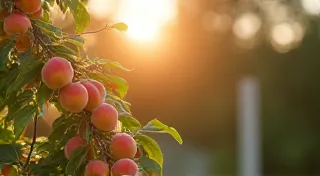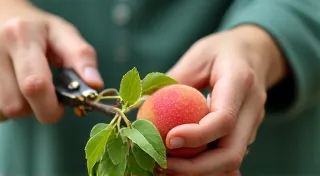Pruning Dwarf Fruit Trees in Containers for Maximum Fruit Yield
Growing dwarf fruit trees in containers is a rewarding experience, allowing you to enjoy fresh, homegrown fruit even with limited space. However, maximizing your harvest requires more than just planting and watering. Pruning is absolutely essential for healthy growth, strong branching, and, most importantly, abundant fruit production. This guide will walk you through the art of pruning your dwarf fruit trees in containers, covering techniques applicable to popular varieties like apples, pears, peaches, and more.
Why Prune Dwarf Fruit Trees in Containers?
Pruning isn't just about aesthetics; it’s a critical practice for dwarf fruit trees in containers. Here's why:
- Encourages Branching: Pruning stimulates the growth of new shoots, leading to a more robust and well-structured tree. Dwarf trees, naturally, have limited growth potential, so encouraging branching is vital.
- Improves Air Circulation: Dense foliage can lead to fungal diseases. Pruning opens up the canopy, allowing for better air circulation and reducing the risk of problems.
- Increases Sunlight Penetration: More sunlight reaching the branches encourages fruit bud formation.
- Shapes the Tree: Container-grown trees benefit from shaping to maintain a manageable size and pleasing appearance.
- Controls Size: While they're 'dwarf' varieties, container growth can still lead to excessive growth if unchecked. Maintaining a manageable size is key, and sometimes even carefully planned budgeting can make a big difference in the overall success of your container gardening endeavors – especially when it comes to acquiring the right sized containers and potting mix. For those looking to start, you can find some budget-friendly tips for growing dwarf fruit trees in containers to ease into the hobby.
Timing is Key: When to Prune
The best time to prune most dwarf fruit trees is during the dormant season, typically late winter to early spring (February - March). This is when the tree is resting and less susceptible to disease. Avoid pruning during active growth periods (spring and summer) unless necessary to remove damaged or diseased branches. Summer pruning can be done to slightly control growth but should be very limited. It's also a good time to think about repotting as part of your regular maintenance schedule – a little extra care in repotting can greatly improve a tree’s health. If you are new to this, you might find this guide helpful: Repotting Your Dwarf Fruit Trees in Containers: A Complete Guide.
Essential Pruning Techniques
Here’s a breakdown of essential pruning techniques applicable to most dwarf fruit trees:
1. Removing the "Four D's"
Always start by removing the "Four D's":
- Dead: Remove any branches that are clearly dead.
- Damaged: Remove branches that are broken, diseased, or otherwise damaged.
- Diseased: Remove any branches showing signs of disease. Cut back well beyond the affected area to prevent spread.
- Deranged: Remove any branches that are crossing, rubbing, or growing in an undesirable direction.
Decide on your pruning style. Most dwarf fruit trees are trained using either a central leader or open-center system.
- Central Leader: Maintain a single, dominant central stem. This is common for apples and pears. Remove any competing upright shoots.
- Open Center: Remove the central leader to encourage growth from several main branches. This works well for peaches and plums.
Understanding the difference between these cuts is crucial:
- Thinning Cuts: Remove entire branches at their point of origin. This encourages growth further down the tree and improves air circulation.
- Heading Cuts: Shorten branches by cutting them back to a bud. This stimulates growth closer to the cut and encourages branching. Use sparingly on dwarf trees as it can result in dense, less productive growth.
4. Specific Fruit Tree Considerations
While the above principles apply generally, here are a few specific tips:
- Apples & Pears: Focus on maintaining a strong central leader and removing water sprouts (vigorous upright shoots).
- Peaches & Plums: Encourage open-center growth and remove fruiting wood regularly (older branches) to promote new growth and younger fruit. Knowing when and how to properly harvest and store your fruit is also vital to long-term success. You can learn more about this here: Harvesting and Storing Your Container-Grown Dwarf Fruit.
- Cherries: Prune lightly to maintain shape and remove any crowded branches.
Container growing introduces additional considerations for pruning:
- Rootbound Issues: Pruning can help mitigate rootbound issues. If the tree is severely rootbound, you may need to repot it into a larger container.
- Control Size: Container growth naturally restricts size, but regular pruning helps maintain a compact form.
- Water Stress: Be mindful of water stress after pruning. Container trees dry out faster, so ensure adequate watering. The challenges of growing fruit in containers can sometimes extend beyond simple pruning and watering – unexpected issues can sometimes arise. If you find yourself facing problems beyond the basics, there are resources to assist you with troubleshooting. Check out Troubleshooting Common Problems with Container-Grown Dwarf Fruit Trees.
Advanced Pruning Techniques for Container-Grown Dwarf Fruit Trees
Beyond the basics, mastering a few advanced techniques can further optimize your container fruit trees' health and yield.
Espalier for Compact Growth
Espalier is an art form that involves training trees to grow flat against a support structure. While typically associated with larger trees, it can be adapted for dwarf fruit trees in containers. This technique not only creates a beautiful ornamental feature but also maximizes sunlight exposure and improves air circulation, leading to increased fruit production. Training your tree using the Espalier method requires patience and consistent effort, but the result is often well worth it.
Creating a "Fruit Spur Gallery"
Fruit spurs are short, stubby branches that produce the majority of a fruit tree's fruit. By strategically pruning to encourage the development of a “fruit spur gallery,” you can concentrate the tree's energy into producing high-quality fruit. This involves identifying existing spurs and selectively removing competing branches to maximize their sunlight exposure and nutrient supply. While this technique requires a more advanced understanding of fruit tree physiology, it can significantly improve the overall productivity of your container-grown dwarf fruit trees.
Dealing with Suckers and Water Sprouts
Suckers are shoots that emerge from the base of the tree or rootstock, while water sprouts are vigorous shoots that grow straight up from the branches. Both can steal energy from the tree and reduce fruit production. It's important to regularly remove these shoots as soon as they appear. When dealing with suckers, make sure to cut them off as close to the root as possible to prevent regrowth. Water sprouts can be pruned back to a bud or completely removed, depending on their size and location.
Understanding the Impact of Nitrogen
Nitrogen is an essential nutrient for fruit tree growth, but too much can lead to excessive vegetative growth and reduced fruit production. When pruning, consider the impact of nitrogen on the tree’s overall health. If the tree is showing signs of excessive growth, reduce the amount of nitrogen fertilizer you’re using. Conversely, if the tree is showing signs of nutrient deficiency, increase the amount of nitrogen fertilizer you’re using. Regular soil testing can help you determine the optimal nitrogen levels for your container-grown dwarf fruit trees.
Conclusion
Pruning dwarf fruit trees in containers is a straightforward process when approached with a basic understanding of the principles. By following these guidelines, you can cultivate healthy, productive trees that reward you with a bountiful harvest of delicious fruit, all within the convenience of container gardening.





